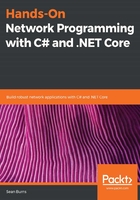
The Host/Media distinction
The first thing to understand about the network stack is that there are different levels of abstraction that you can view. The higher up, conceptually, that you look at network interactions, the fewer layers there are, and the easier it is to distinguish between the responsibilities of those layers. Meanwhile, when you build a model closer to its concrete implementation, you see the distinctions between more subtle roles and responsibilities of each entity in that model. We're going to be looking at the full, lower-level model provided by the OSI reference model, but I want to take a moment to consider the higher-level distinction between entities on a network, which breaks down into two fundamental layers.
The first of these layers is the Host layer. This encapsulates the four higher levels of the OSI stack and describes entities or responsibilities specific to a given host trying to communicate on a network. In the most basic context of two-way communication between two hosts on a network, each host is responsible entirely for its own implementation of the OSI layers that aggregate up under the Host layer (hence the name). Bundling application data, specifying encoding and reliability expectations, and the methods for sending out a PDU to a given target all fits, loosely, under the Host layer.
The second layer in the higher-level view of networks is the Media layer. These layers describe the physical implementation of the network components between two hosts. This provides the expected functionality specified or requested by entities in the Host layers. Entities of this layer are typically implemented either on the hardware level, or in a low-level systems language such as C or C++. For this reason, entities of this layer will generally fall outside the scope of this book. However, C# provides abstractions that encapsulate and represent the functionality of entities in this layer, so it's important to understand how the layers that fall under the Media layer actually work on a basic level.
With that high-level distinction made, let's take a look at the full OSI model for networks, starting from the top.